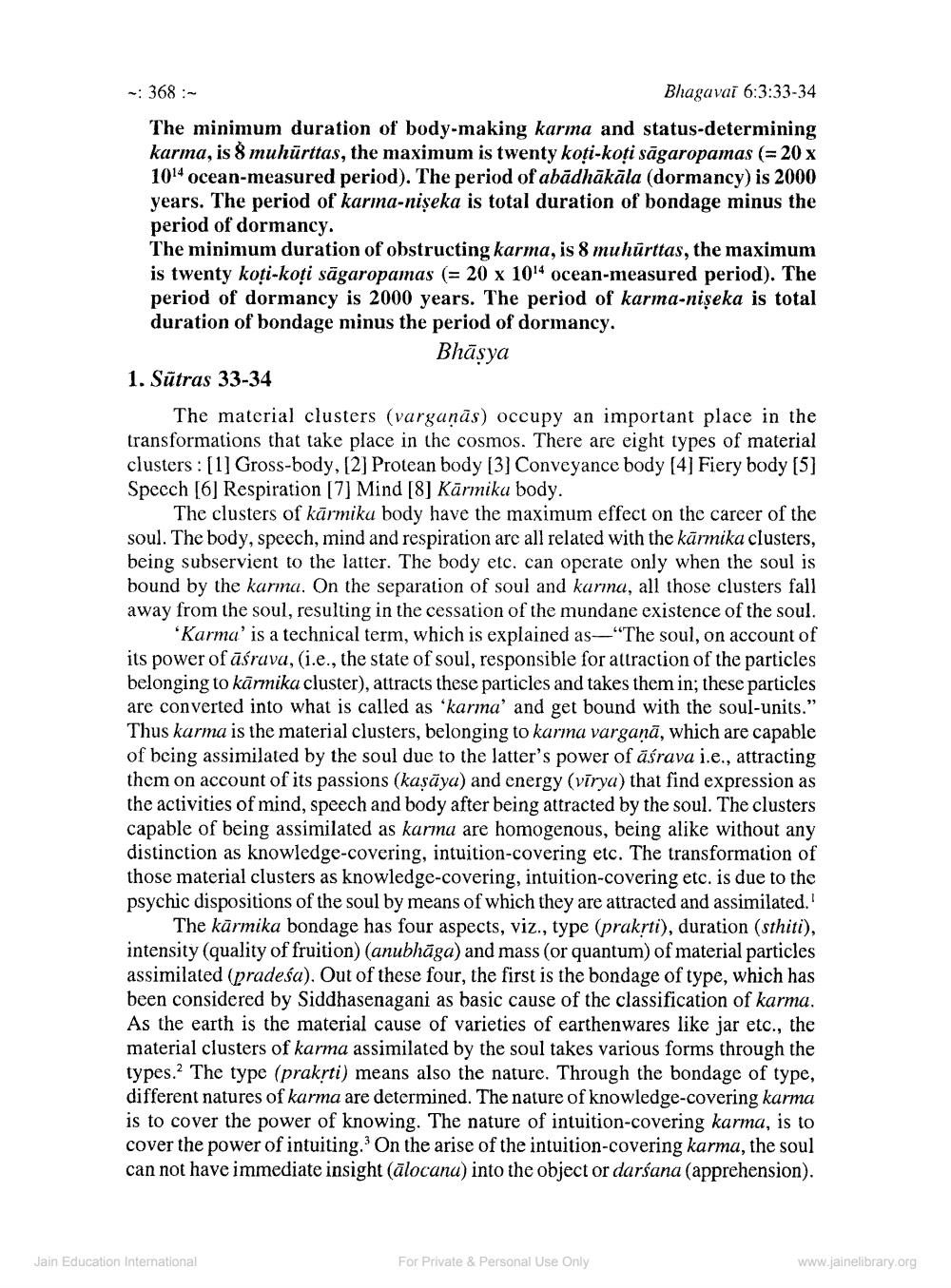________________
-: 368 :
Bhagavai 6:3:33-34 The minimum duration of body-making karma and status-determining karma, is 8 muhūrttas, the maximum is twenty koti-koți sāgaropamas (= 20 x 1014 ocean-measured period). The period of abādhākāla (dormancy) is 2000 years. The period of karma-nişeka is total duration of bondage minus the period of dormancy. The minimum duration of obstructing karma, is 8 muhūrttas, the maximum is twenty koti-koti sāgaropamas (= 20 x 1014 ocean-measured period). The period of dormancy is 2000 years. The period of karma-nişeka is total duration of bondage minus the period of dormancy,
Bhāsya 1. Sūtras 33-34
The material clusters (varganās) occupy an important place in the transformations that take place in the cosmos. There are eight types of material clusters : [1] Gross-body, [2] Protean body [3] Conveyance body [4] Fiery body (5] Speech [6] Respiration [7] Mind [8] Kārmika body.
The clusters of kārmiku body have the maximum effect on the career of the soul. The body, speech, mind and respiration are all related with the kārmika clusters, being subservient to the latter. The body etc. can operate only when the soul is bound by the karma. On the separation of soul and karina, all those clusters fall away from the soul, resulting in the cessation of the mundane existence of the soul.
Karma' is a technical term, which is explained as—“The soul, on account of its power of āśruva, (i.e., the state of soul, responsible for attraction of the particles belonging to kārmika cluster), attracts these particles and takes them in; these particles are converted into what is called as 'karma' and get bound with the soul-units." Thus karma is the material clusters, belonging to arina varganā, which are capable of being assimilated by the soul due to the latter's power of āśrava i.e., attracting them on account of its passions (kaşāya) and energy (vīrya) that find expression as the activities of mind, speech and body after being attracted by the soul. The clusters capable of being assimilated as karma are homogenous, being alike without any distinction as knowledge-covering, intuition-covering etc. The transformation of those material clusters as knowledge-covering, intuition-covering etc. is due to the psychic dispositions of the soul by means of which they are attracted and assimilated.'
The kārmika bondage has four aspects, viz., type (prakrti), duration (sthiti), intensity (quality of fruition) (anubhāga) and mass (or quantum) of material particles assimilated (pradeśa). Out of these four, the first is the bondage of type, which has been considered by Siddhasenagani as basic cause of the classification of karma. As the earth is the material cause of varieties of earthenwares like jar etc., the material clusters of karma assimilated by the soul takes various forms through the types. The type (prakrti) means also the nature. Through the bondage of type, different natures of karma are determined. The nature of knowledge-covering karma is to cover the power of knowing. The nature of intuition-covering karma, is to cover the power of intuiting. On the arise of the intuition-covering karma, the soul can not have immediate insight (ālocana) into the object or darśana (apprehension).
Jain Education International
For Private & Personal Use Only
www.jainelibrary.org




